There are two main types of bass amplifiers on the market today: tube (or “valve” for us Britons) and so-called “solid-state” designs. But despite the seeming simplicity here, the everyday reality of finding the right bass amp for your needs is much trickier than you’d expect. For starters, although tube circuits have been around for decades, many bassists still don’t really understand them. But recent advances in solid-state technology have even greater potential to be confusing. In this article we’re going to demystify one of the most important areas of amp design that even many experienced bassists don’t adequately grasp—power-amp types and their associated power ratings.
The reason we’re focusing on these is because amplifying beefy bass frequencies—moving all that air and thumping listeners’ chests—requires far more power than a guitarist needs to wail on a 6-string. And once you’ve got a deeper understanding of how to ascertain the true power capabilities of an amp, the better you’ll be able to navigate the sea of marketing-speak and tech talk surrounding amps large and small.
In order to dive deep on these two topics, though, we need to discuss a few aural and electrical basics first. To some our conversation might feel pretty complicated in parts, but I promise that if you stick with me through the tech talk, I’ll tie it all together so you’ll walk away with newfound clarity and practical knowledge that’ll save you a lot of money, time, and hassle in the long run. In fact, you might find yourself asking, “How come no one ever explained all this before?”
The Science of Sonics

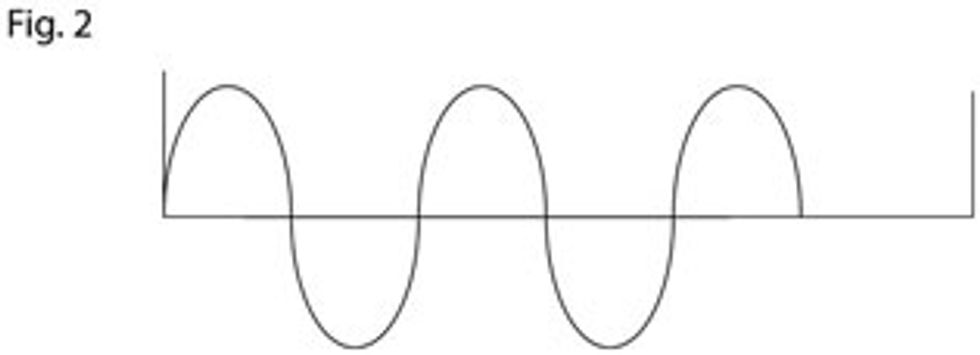

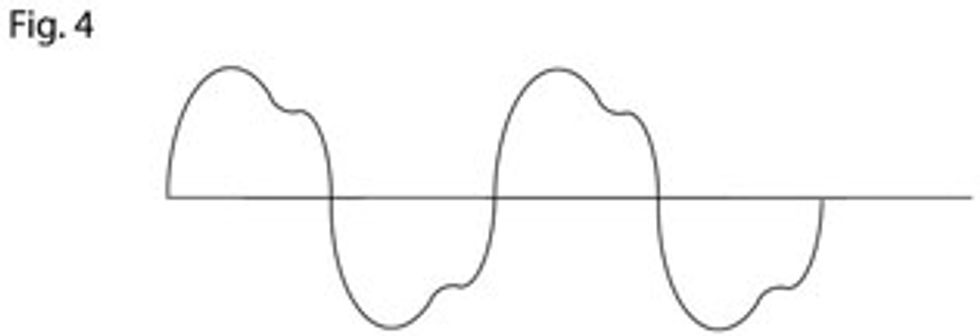
AC Meets DC, and Watts Are Born
Now let’s briefly look at some power fundamentals. A battery such as the 9V units used in effects pedals produces direct current (DC). The electricity from DC sources is under pressure to flow continuously like water from a tap. The unit of measure for this pressure is volts (V), and the rate of the flow is measured in amperes (A). When we multiply V x A, we get Watts (W)—the unit of measure for the power being used.
However, things aren’t quite so simple when the current flows back and forth like the alternating current (AC) from a wall socket. The waveform for AC current should look like that produced by the vibrating string in Fig. 2. Another equation calculates the power contained within this alternating waveform—averaging it over time—in order to relate it directly to DC current. The equation involves a bunch of dual-axis chart graphing and square-root stuff that most players have no interest in. The resulting values from this more complicated math are designated RMS (for “root-mean square”), and with these RMS values the same V x A = W equation we used for DC current now holds true for AC: V (RMS) x A (RMS) = Watts (Avg).
Watts (Avg) is often incorrectly referred to as “RMS power,” “RMS watts,” or “watts RMS.” However, the RMS value of the power waveform is different from the average power value (22 percent higher for a sine-wave signal), and therefore should not be used. The correct term specified by the Federal Trade Commission is continuous average power. Continuous average power ratings are a staple of performance specifications for audio amplifiers and, sometimes, loudspeakers.
Basic Amp Operation
Now let’s look at how amplifiers work. Amps need the pressure (volts) of the AC power from the wall socket adjusted in order to make it suitable for use with your bass and speakers. This is usually done by means of a transformer or a switch-mode power supply (SMPS). The transformer and SMPS also convert alternating current to a smooth, steady direct current. This steady stream of power must then be regulated by an electronic “tap.” In a tube amp, the tubes function as the tap regulating the flow. In a solid-state amp, it’s transistors.
As your bass string vibrates over the pickup (which is, in fact, a tiny generator), an electrical waveform is produced and then fed to the amplifier, where it is made larger and used to turn the transistors or tubes on and off in a matching way so as to produce a larger version of the bass-note waveform. In order to respond quickly to notes you might play at any moment, the tubes or transistors in your amp are always turned on slightly—like a car engine idling, ready to take off when you press the accelerator. The rate of this idling state is known as the bias setting in tube amps. Transistor amps also have bias, though it usually isn’t adjustable. We’ll talk more about bias later.
You’ll recall that we said amps send DC to power the electronic taps. But if the stream of current is steady regardless of how much gets used up amplifying a signal at any given moment, what happens to the power not being used? The answer, my low-end-loving friends, is why moderate- and high-powered bass amps these days have cooling fans and/or heat sinks: The excess current is turned into heat that must be dissipated in order to prevent damage to the circuit. This is how conventional linear amplifiers operate, and there are two basic types of these: class A and class B. (There are also sub classes such as class AB.)
The weight of a traditional amplifier, like the one shown here, comes largely from its massive transformer—the circular object on the left. The amp’s discrete components on the circuit boards make it easy to repair by a qualified tech. In this type of amp, excess current is turned into heat and then dissipated by heat sinks (right) or a fan.
Class A and B vs. Class D
Let’s look at linear amps a little closer. In the sine wave in Fig. 2 we can see that the wave has a central point, which is known as the X axis. Graphically speaking, this corresponds to the position of the string at rest. The wave goes positive first, then negative, then returns to rest before beginning its next cycle. To amplify this we need a central point about which to cycle the electrical equivalent of this wave. In a pure class-A tube or solid-state amplifier, this central point is half of the available volts. The tubes or transistors then turn more on or off to produce the amplified wave, which means the tubes or transistors process all of the signal, all of the time—there are no breaks, joints, or delays in the signal. It remains as sonically pure as possible.
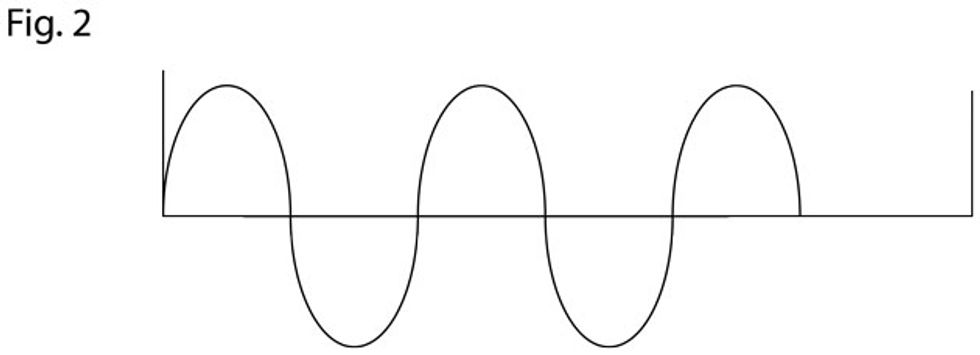
In a class-B tube or solid-state amp, the center point is at zero volts, and two supplies are used—one positive and one negative. In such a case, two sets of tubes or transistors are used, with one set handling the positive half, and the other the negative half. This setup makes class-B amps far more efficient, with greater output potential. However, as the wave crosses the zero point and the positive half turns off and the negative half turns on, there has to be a slight overlap between the two sides to avoid breaks in the output (sound). This is where the aforementioned bias setting comes into play, ensuring that both sets are turned on slightly all the time. In a class-AB amp, the bias is set higher than a class-B amp, making the overlap between the two halves larger.
In recent years, a third amplifier type—class D—has become increasingly popular, thanks to its small size, light weight, extreme efficiency, and affordability. In class-D amps, the transistors turn full on or full off very fast—up to 500,000 times per second—positive on then off, negative on then off, and so on. Without getting too deep into electrical stuff, let’s just say that class-D amps are more efficient because the sound from the instrument is used to control the length of time transistors in the power section are on or off. Because of this greater efficiency, class-D amps generate far less heat than class-A and class-B amps. But they are not without their problems. The output must be filtered to get rid of the switching noises, and extensive protection mechanisms are needed to prevent damage to the power supply, speakers, and other parts due to overheating or power overload. If a class-D amp does get overloaded or overheats, power will switch off for 5–10 seconds and then reset.
all this before?”
How to Make Sense of Power Ratings
Okay, folks, we’re getting closer and closer to the crux of our power conversation. Remember when we talked about continuous power output? For a very long time that was the most widely accepted basis for amplifier power ratings, because it has a direct correlation to real-world needs. However, over the last few years myriad other power-rating formulas have been invented or brought back from obscurity. To be blunt, the only reason I can see for some of this is to fool consumers who can’t make sense of all the technical terminology and to make products sound more powerful than they actually are. These other rating types include burst power, peak music power output (PMPO), and fast pulse power before clipping (FFP).
To measure an amplifier’s power, we feed a sine wave (Fig. 2) into the front of the amp, connect a load of the correct impedance to the output, and turn it up. Maximum output is reached when the top or bottom of the waveform starts to flatten out, a phenomenon known as clipping. The output is then measured and noted.
Now let’s look at how output ratings are listed on some products currently for sale on the market. (We aren’t disclosing makes or models, because the point here is to make sense of all those numbers, terms, and acronyms.) If an amp is listed as having “continuous power output of 500 watts RMS into 4 ohms at 1% THD,” it means that, at the point of clipping, the amp can produce 500 watts of electrical power on a sustained, continuous basis.
Those two words—“sustained” and “continuous”—are key because they indicate a stamina that is crucial to certain musical situations. That’s a good thing, and here’s why: The waveform we’ve been looking at so far depict steady-state waves, but when you’re playing bass it’s not just one steady note with no dynamics. There’s a larger peak at the onset of the note when the string is plucked, followed by the decay as the string ceases vibrating. Fig. 5 looks more like the waveforms in composite music reproduction, where there are peaks due to loud sounds (such as drum beats) and lower sounds (like vocals and backing instruments).
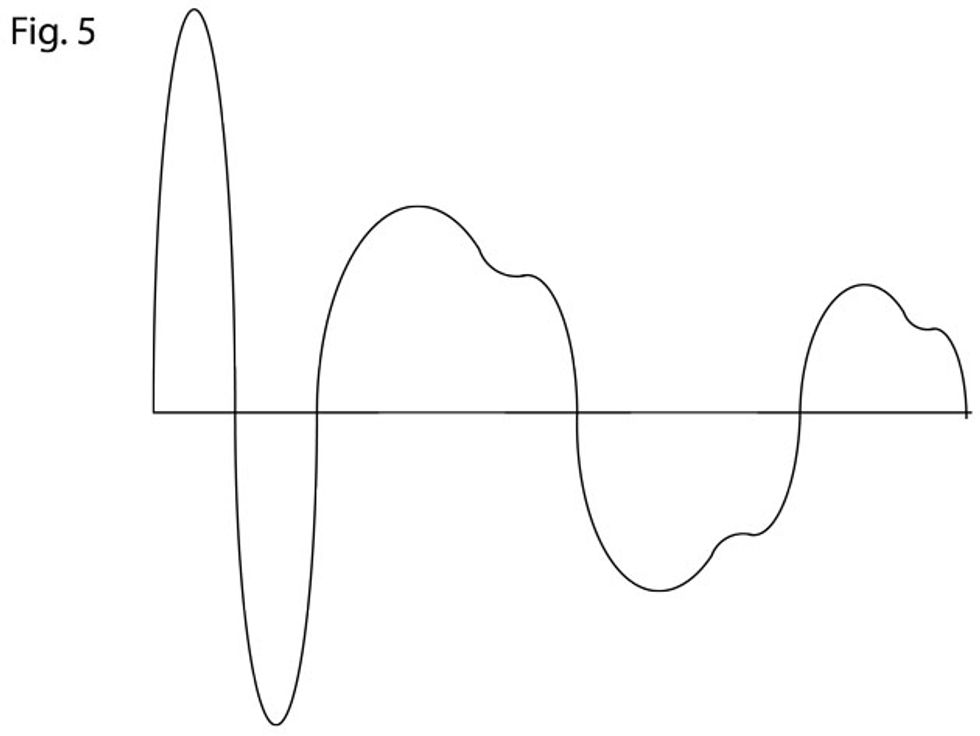
In 1959 the British tube manufacturer Mullard noted in its Circuits for Audio Amplifiers guide that the average continuous output power required for general music reproduction (e.g., a recording of a band) was approximately an eighth of continuous power at full volume if the transients (large peaks in the waveform caused by sudden, loud signals) were to remain unclipped. This is a power rating system that has reared its ugly head again recently, especially with regard to lightweight class-D amplifiers. Most class-D bass amps today use small power modules designed for general music reproduction—not low-frequency-heavy bass—and they are rated using this 1/8th-power system rather than the more robust continuous average power rating.
Here’s part of the power specifications for a bass amp using a typical class-D power module:
Key Specifications:
• 300W at 1% THD+N, 4Ohm
• Full power bandwidth (20Hz – 20 kHz)
• 113dBA dynamic range (300W, 4Ohm)
• THD+N = 0.005% (1W, 4Ohm)
An amp with these specs will be marketed as a 300-watt amplifier. But what the specs don’t tell you is that this class-D amp module can only sustain 300 watts of output for a maximum of 27–60 seconds! This is more or less the norm for all class-D modules, and it’s perfectly acceptable for, say, playing MP3s of your favorite band. But if we go back to Mullard’s average continuous formula and calculate backward, we find that only 1/8th of those 300 watts—about 38 watts—is continuously available. This rather optimistic math is used as justification for selling what’s really a 60-watt amp as a 300-watt.
A class-D amplifier lacks a transformer, which means it’s much lighter than a traditional amp and it generates very little heat. But if the power module fails, it typically can’t be repaired. Replacing it is so expensive that most players opt
to buy a new amp instead.
Know Your Needs
Despite what I’ve just said, I want to make it clear that I’m not saying class-D amps can’t sound good and perform well for bass players. But whether they’re right for you does depend on what you play, how you play, and what other gear you use. For example, if you’re a slap player who uses the bass as more of a percussive instrument (like Mark King of Level 42, for example), the waveform going from your bass to your amp will be very similar to general music waveforms. It’ll have a series of large peaks (transients) and a lower average power demand. That means serious output power is not required for any length of time. This is more or less perfect territory for the typical class-D amp.
The situation changes somewhat for players who use compressors, because compressors remove the large transients and elevate the decaying note so that the resultant wave more closely resembles a continuous waveform. The more compression, the more continuous the waveform gets (Fig. 4). And the higher average volumes that compressors and limiters promote require more amplification power for a longer period of time. Throw in some pedals, perhaps a sub-harmonic generator or an oscillator, and the problem is compounded even more.
Some manufacturers of class-D amps have started to address this problem by fitting extra heat sinks and cooling fans to the power modules in an attempt to push the continuous power ratings higher, prevent thermal shutdown, and make the modules more suitable for musical-instrument amplification. But there is still some distance to go in this regard.
Another crucial thing to remember when buying a bass amp is that frequency response is intimately connected to power ratings. In a tube amp, the lowest frequency that can be reproduced is determined by the size of the output transformer and its ability to transfer the low frequencies to the speaker. It’s usually around 30 Hz. In solid-state linear amps (class A, B, AB, etc.), the low frequency that can be reproduced is approximately 20 Hz—the lowest frequency humans can hear. But some class-D amplifier manufacturers limit the lowest frequencies to around 60 or 70 Hz to use less of the already-low continuous power and make the amp sound louder. The result is usually an amp that sounds boxy and has no real low-end substance.
Similarly, it’s critical to consider how an amp will react to being overloaded by, say, stepping on an external boost or fuzz pedal, or by cranking the gain and volume to max. Whether this is a big deal to you will depend largely on the genre of music you play. Tube amps tend to growl and snarl in a way that can be very pleasing. For rock bassists, nothing comes close to the sound of a good tube amp at full bore. Traditional linear class-A and class-B transistor bass amplifiers also tolerate quite a bit of overloading, although most players don’t find the distortion to be as pleasing as tube distortion.
without their problems.
Class-D amps, on the other hand, do not tend to react well to overloading due to built-in protection mechanisms. Under slight overload the amp will limit or cut the output momentarily, and under heavier overload the output gets switched off completely for a few seconds. The leading manufacturer of OEM class-D modules has fitted the latest models with soft clipping in an attempt to solve this problem, but there is some distance to go before the problem is solved. However, if the style of music you play is less likely to result in overload situations (for instance jazz or fusion), this may be less of a concern.
Worst-Case Scenarios
Bass amps from reputable makers should be reliable if you treat them properly. However power sections do die sometimes, and here is where another big difference between amp types emerges. Tube amps usually blow tubes, which is no big deal: You buy some more, plug them in, maybe have a tech re-bias them, and enjoy months or years of great tone. It’s easy, simple, and not too expensive. This is why hundreds, maybe thousands, of old tube amps are still being used onstage and in the studio decades after they were built.
Traditional class-A or class-B transistor power amps are also usually very easy to repair. Parts are available from most electronic suppliers, and a good tech can diagnose and fix the problem at reasonable cost by replacing only the parts that have blown up.
The power modules in class-D amps, however, usually cannot be repaired. If the power section fails, paying a tech to replace the power module will cost about half as much as the complete amplifier. In these cases, most players will opt for a new amp instead. This represents a total loss to the customer, and is also bad for the environment because the surface-mount circuit boards in most of these amps are hard to recycle into anything useful. Then there is the second-hand value to consider: A lot of musicians primarily raise funds for new purchases by selling old gear. Tube amps seem to go up in value as they get older. Traditional heavyweight linear amplifiers also do well, largely because their low repair costs mean if you buy a duffer it can be fixed without breaking the bank. Sadly, many modern lightweight class-D amps with surface-mount modules that cannot be repaired have almost no residual second-hand value.
Armed and Dangerous
We’ve covered some pretty heady territory here, but now that you have a better understanding of power-amp types and their power ratings—one of the most mysterious and significant areas of amp design—you’ll be able to make your next amp purchase much more confidently.
It’s worth noting that almost all the big bands and pro musicians use old-school, heavyweight tube or solid-state amps, and the particulars we’ve discussed here are a huge reason why. But like I said, class-D amps can be solid performers. Just be sure to pay attention to the fine print. If you’re interested in a lightweight class-D unit, be sure to select the right output power. If a 200-watt tube or traditional solid-state amp would meet your power needs, double that and get a 400-watt class-D amp to be safe—it won’t weigh much more.
There are a lot of very good amplifiers out there—tried-and-true designs that are still in production after many years, as well as modern heavy and lightweight designs from outfits new and old. So try as many as you can, don’t rush into anything, and buy the best that you can afford. Happy hunting!



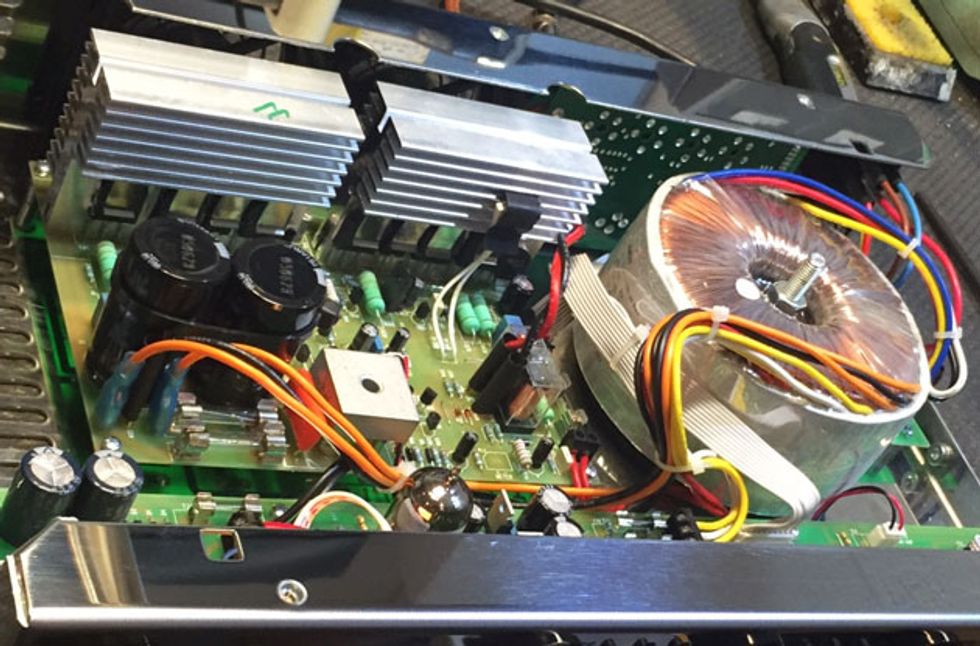
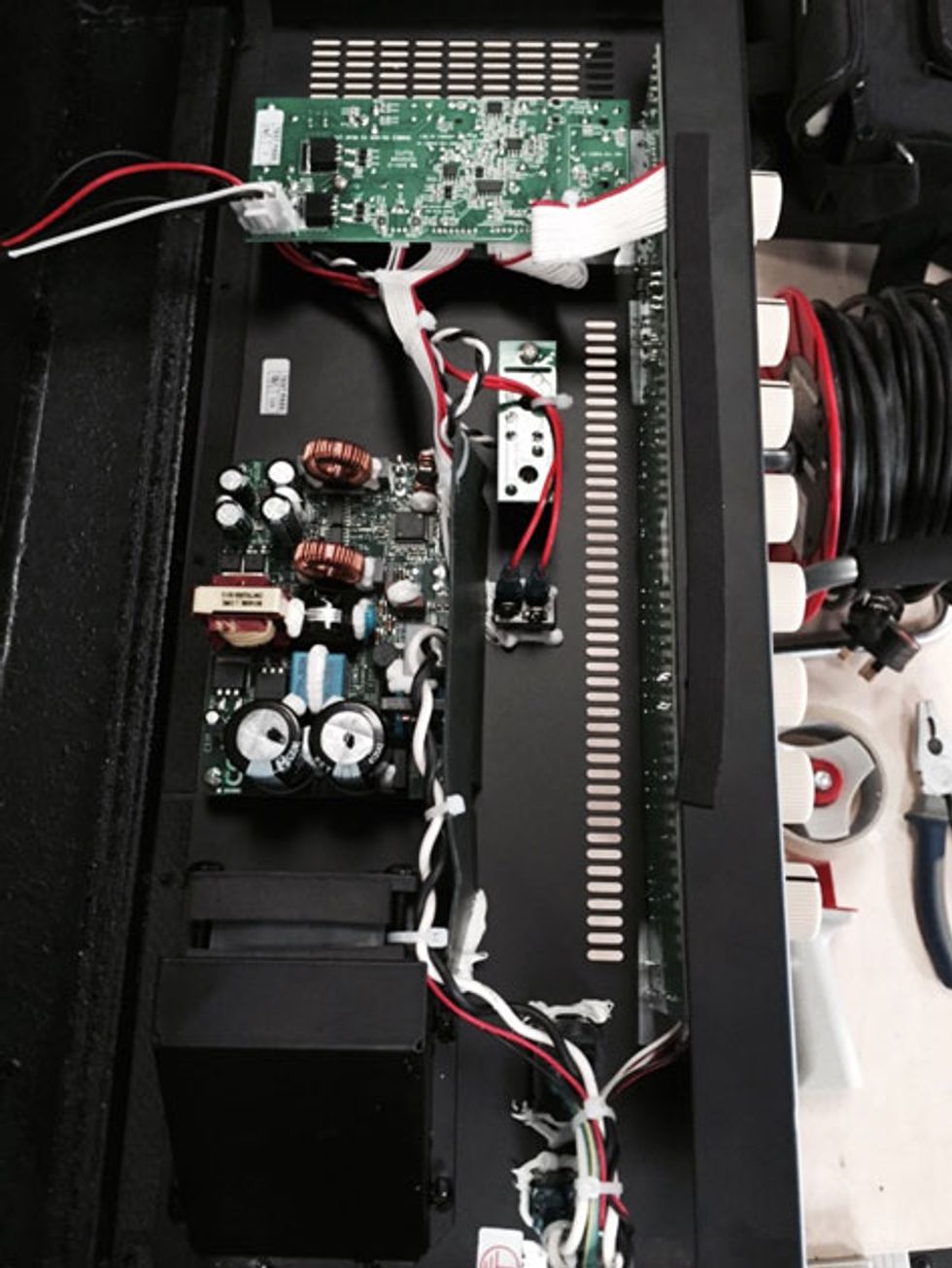




![Rig Rundown: AFI [2025]](https://www.premierguitar.com/media-library/youtube.jpg?id=62064741&width=1245&height=700&quality=70&coordinates=0%2C0%2C0%2C0)












 Shop Scott's Rig
Shop Scott's Rig















































